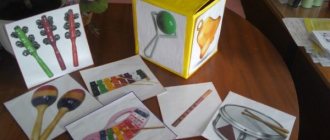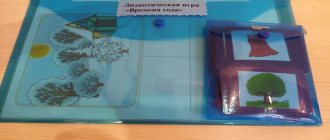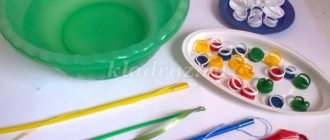Card index “Didactic games on folk culture” (senior preschool age)
Lyudmila Yanovskaya
Card index “Didactic games on folk culture” (senior preschool age)
Card file " Didactic games on folk culture "
(senior preschool age)
D/I “Find a thing”
Target. Improve your ability to describe different objects.
Game task. Describe the item together.
Rules of the game . Describe the item as accurately as possible.
The game takes place in the "hut"
.
Invite the child to describe the object without naming it, for example: “The handle is long, wooden, it is made of metal, long, sharp, like a knife
. The one who guessed correctly gets a chip. The next item is described by another child.
D/I "Exhibition of antiques "
Target. Improve children's understanding of how to classify objects according to typical characteristics. Teach children to empathize with the successes and failures of their peers.
Game task. It is interesting and understandable for others to describe the subject.
Rules of the game . Talk about the purpose of the item. Participate in the competition.
Material. Exhibits of the "hut"
or
cards with their image .
A game. Children are divided into “guests”
and
the “owners”
of the hut.
The “host”
must describe the item in such a way that
the “guest”
can immediately guess what it is about.
Option. Invite children to organize a competition, describing things using poems and riddles. The picture will be received by the one whose description is recognized by everyone as the best.
D/I “Dress the doll in a national costume”
Target. To consolidate children's knowledge about the items of Russian national costume (summer and winter, men's and women's)
.
Game task. Dress the doll correctly.
Rules of the game . Select clothes for men and women according to the season.
Material. For each child a set: cardboard flat dolls and clothes made of thick paper.
A game. Children are invited to dress dolls in national costumes (summer and winter)
.
The teacher asks questions to consolidate the general concepts of “clothing”
,
“shoes”
,
“hats”
.
D/I “Pick up objects from the picture ”
Target. Develop an interest in looking at objects, noting their beauty. Create a desire to create a still life by arranging objects in a certain sequence.
Game task. Pick up items using large cards .
Material. Large cards depicting various still lifes with objects presented in the mini-museum of folk life .
A game. Children take cards , look at them, and exchange impressions. Then they select objects stored in the museum and compose still lifes in accordance with the card .
D/I “Make a pattern”
The goal is to practice composing patterns from geometric shapes, rhythmically following the line of the ornament, to expand ideas about the compositional construction of patterns on square and round shapes.
Game task: make a pattern on the “towel”
,
"plate"
,
"shawl"
.
Rules of the game : lay out geometric shapes, alternating by color, size, using compositional schemes.
Material: sets of geometric shapes, bases for laying out patterns, compositional diagrams.
A game. The teacher suggests looking at large geometric shapes, what color they are, what they look like: a circle-plate, a square-scarf, etc. Invites the children to make a pattern on them.
D/I “Russian souvenir”
The goal is to consolidate knowledge about the features of products from Filimonovo, Dymkovo, Khokhloma, Gzhel (purpose, toys, dishes, shape, colors of painting, teach yourself to create an expressive image.
Game task: make a Russian souvenir for guests.
Rules of the game : create a souvenir based on one of the paintings.
Material: templates for Dymkovo and Filimonov toys, dishes, a set of colored stripes, a set of strips with elements of painting.
Additional materials: gouache, brushes, scissors, paper.
Game: Invite children to find out the type of toys and dishes using the patterns. Tell us what elements, what colors and on what background you can decorate them (based on samples of backgrounds and paintings)
.Offer to make a Russian souvenir: trace the template on paper, paint it, cut it out, tell what kind of painting you used.
D/I “Decorate the hut”
The goal is to consolidate knowledge about the elements of decorating a hut: porch, towel,
platband, shutters; about the purpose of patterns - “amulet”
; develop fine motor skills of fingers.
Game task: decorate the hut, “protect from evil forces”
Rules of the game : lay out a pattern on the decoration elements of the hut.
Material: “hut”
, (in place of
the “towels”
,
“blinds”
,
“shutters”
,
“platbands”
pieces of flannel are glued); sets of geometric shapes.
Game: invite children to decorate the hut with patterns - amulets, and after completion, talk about the meaning of the elements.
D/I “What comes first - what comes next”
The goal is to teach how to compare objects of different types, identifying similarities and differences (by time of origin, by material, by function)
;
consolidate general concepts: furniture, dishes, shoes, clothing.
Game task: pick a pair.
Rules of the game : select a pair based on a certain characteristic.
Material: a set of cards of Russian household items, clothing, shoes and modern ones (bast shoes, sneakers; pot-pan; ponyova-skirt, etc.)
.
Game: invite children to look at the pictures and put them in pairs.
1. What happened first, what people came up with later (pot-pan, etc.)
- objects have the same function;
2. From one material (pot-jug, etc.)
;
3. Combine into groups (furniture, clothes, shoes, dishes)
Children must explain their choice.
D/I “Find out what this is?”
Target. Development of attention and imagination.
Rules. Find out an object from the “hut”
according to the outline image on
the card .
Material. Cards with outline images of objects from the “hut”
.
A game. Each child receives a card with a schematic image of a household item. The teacher invites the children to recognize the object, name it, and find it among the exhibits.
D/I "The Fourth Wheel"
Target. Teach children to combine objects into groups according to a certain property, to distinguish the results of the work of craftsmen - a potter, a blacksmith, a carpenter and a seamstress. Develop logical thinking.
Rules of the game . Identify an item that is not suitable for others as the result of the work of a person of a certain profession.
Material. Sets of pictures (jug, bowl, cup and chair, etc.)
A game. Place in front of the child four pictures depicting objects, three of which relate to the results of the blacksmith’s work. Having defined the “extra”
, i.e.,
a picture the child receives a chip.
D/I “Lunch for nesting dolls”
Target. Develop auditory attention.
Game task. Feed the nesting dolls.
Rules of the game . Clap your hands when you hear the name of a food item.
Material. Matryoshka dolls.
A game. Invite the children to feed the nesting dolls, the teacher names food and inedible items mixed together, and the children should clap their hands when they hear the names of food products.
D/I “Which objects were made by the blacksmith, and which by the potter?”
Target. Clarify children's knowledge about the various materials from which objects are made: metal, clay. Learn to master ways of studying subjects.
Game task. Find objects made from the same material.
Rules of the game . Name the characteristics of materials without repeating those already named.
Material. Groups of ancient and modern everyday objects made of metal - spoon, fork, braid, etc.; made of clay - bowl, vase, whistle, etc.
A game. All objects are on the table, on separate tables there are pictures depicting a forge and a pottery workshop. The teacher asks the children to name the professions of the people working in these workshops. He asks to find the products created by these masters and place them on the tables. First, objects are compared based on common characteristics, then differences between two groups of objects are identified.
D/I “What has changed?”
Target. Consolidate knowledge about the purpose of toys, household items ( antiques) , their classification. Develop memory and intelligence.
Game task. Guess what has changed.
Rules of the game . Don't peek. Keep a secret about moving toys.
Material. Thematic selections of toys and objects.
A game. Place the toys behind the screen, move it aside and invite the children to remember the order of the objects. Behind the screen, swap them (first one, then two, three)
. Children must guess what has changed and restore the previous order.
FOLK ROOTS OF DIDACTIC GAME
Didactic games have existed for many centuries. Their first creator was a people who noticed an amazing feature of young children - their receptivity to learning through play, with the help of games and toys. Over the entire history of mankind, each nation has developed its own didactic games, unique didactic toys have been created that have become part of its culture. The content of didactic games and toys reflected the features of the national character, nature, history, labor, and life of a particular people. But we can also trace something common, characteristic of all didactic games and toys, regardless of what corner of the globe they originated. They clearly demonstrate the view that has developed in the ideas of different nations of a child as a being who, for his full development, needs knowledge of the world around him, a joyful mood, emotionally charged communication with people close to him, active actions, movements that allow him to open up and express himself. . With good reason, we can consider folk didactic games as the embodiment of a humane, respectful, caring attitude towards the strengths, capabilities, and developmental trends of the child.
Folk didactic games provide a relationship between educational and training influences, taking into account the age-related psychophysiological characteristics of the child. Folk didactic games are characterized by clearly expressed educational emotional and cognitive content, embodied in playful form, imagery, and dynamic play actions. The content of the game is event-based, i.e. reflects an incident, an incident that evokes a certain emotional response in a child and enriches his social experience.
The classics of Russian folk pedagogy have become such didactic games as “Magpie-White-sided”, “Guli-Guli”, “Ladushki”, “Jumpers”, “Fanta”, “Barynya”, “Paints” and many others. From generation to generation, didactic toys created by the people are passed on for the development of speech, will, attention, accuracy and coordination of movements, the formation of ideas about color, shape, size, spatial arrangement of objects (sprinkles, folding barrels, eggs, cones of bright colored rings of different sizes , nesting dolls, pyramids, turrets). The content and design of didactic toys reflected the idea, characteristic of Russian folk pedagogy, of instilling independence in children as the most important feature of national character. Many toys provide the opportunity for a child to self-learn through play actions, their repetition, finding the correct solution to a problem, and achieving a successful result. The method of play action is often suggested by the very design of the folk didactic toy, which meets the task of fostering independence in play.
In Russian folk pedagogy there are didactic games and toys intended for children of different ages: from early childhood to school. They enter a child’s life very early - in the first year of life. Mother playing with a 7-9 month old baby. from birth, attracts his attention to surrounding objects, teaches the first play actions. So, listening to “The White-sided Magpie,” the baby fingers the fingers of his hand, shakes his little finger, which did not get porridge because he “didn’t bring chaff,” “didn’t go for water, didn’t carry firewood, didn’t cook porridge,” raises his hands to the head with the words “Shu, shu! Sat on my head!” And a 2-year-old child, willingly participating in the roll call game, learns to speak, participate in dialogue, and acquires the first concrete ideas about norms of behavior. Simple rhyming texts that make listeners want to recite them, stimulate simple play actions, create a joyful mood in the child, and satisfy the need for active knowledge of the world around them.
For older children, Russian folk pedagogy intends didactic games, which provide the opportunity to develop activity, dexterity, initiative, and ingenuity. Here the inherent need for preschoolers to move and communicate with peers is expressed; there is abundant food for the work of the mind and imagination. Inventiveness, jokes, humor, and an optimistic character are the distinctive features of Russian folk games. They teach the child to overcome difficulties, rejoice at winning, and courageously endure failure. Each folk game solves a complex of educational problems. Thus, the game “Mistress”, in which there are many prohibitive rules (“don’t say yes or no, don’t laugh, don’t smile, don’t choose black and white”), unobtrusively teaches the child self-control, the ability to subordinate feelings to reason; develops memory and flexibility of thinking.
Over time, folk games are subject to changes made by the children themselves (updating the content, complicating the rules, using different gaming material). Variants of games are created by practicing teachers. Based on the ideas inherent in folk games, scientists create new didactic games and offer entire systems of such games.









